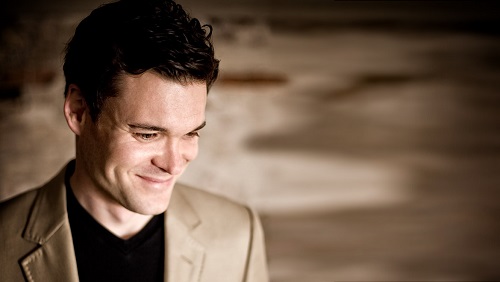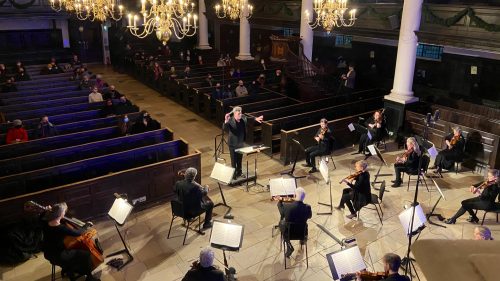 United Kingdom Sibelius, Nielsen, Wagner, Mozart: Academy of St Martin in the Fields / Ryan Wigglesworth (conductor). St Martin-in-the-Fields, London, 5.12.2020. (MB)
United Kingdom Sibelius, Nielsen, Wagner, Mozart: Academy of St Martin in the Fields / Ryan Wigglesworth (conductor). St Martin-in-the-Fields, London, 5.12.2020. (MB)

Sibelius – Belshazzar’s Feast, ‘Nocturne’
Nielsen, arr. Hans Abrahamsen – Three Piano Pieces Op.59, recomposed for ten instruments
Wagner – Siegfried-Idyll
Mozart – Symphony No.34 in C major KV 338
‘Awakening’, aptly enough, was the theme of this post-lockdown concert from the Academy of St Martin in the Fields in the church where, for this orchestra, it all began. I only noticed that after the event and confess to having been thinking in different, if far from opposed, terms, related to the theatre. Music means many things at different times, to different people—and surely all the more so in times such as these. At any rate, a sign of musical light in London at the close of the first week of Advent was welcome indeed, not least given the typical accomplishment of the Academy’s playing, this time under Ryan Wigglesworth.

As a heretic who has always preferred Sibelius’s smaller pieces to his symphonies — perhaps one day they will ‘click’ with me — I was delighted to hear the ‘Nocturne’ from his incidental music to Belshazzar’s Feast in a spacious performance, well-judged for the church acoustic. One heard from the outset coolness and warmth in the Academy’s sound, both in timbre and harmony. Such balance was typical of the performance as a whole, Tchaikovskian inheritance apparent, yet neither overwhelming nor overwhelmed by Sibelian distinctiveness of voice. Scalar orientalism may have charmed, yet sounded rightly incidental (in the other sense). Here was a Nordic heart beating throughout.
Hans Abrahamsen’s ‘recomposition’ of Carl Nielsen’s Three Piano Pieces had no intrinsic connection with the stage, yet sounded here very much as if it had. The first piece set the scene for quite a journey within only a few minutes. Quirky, colourful, yet with enough disorientation to retain a welcome enigmatic quality, it proved neither one thing (Nielsen) nor the other (Abrahamsen), albeit in a positive, alchemic sense: if not quite the magic of theatre, then certainly of performance, the latter here one of sensitivity and verve. The second proved similar yet different, a second act in miniature. Here a sense of kinship with Maskarade seemed stronger, but likewise tendencies in another, re-composer’s direction. Likewise, still more, in the third: whether that were a matter of work, performance, or my listening, I am not entirely sure. And does it matter? Some wind sounds, perhaps inevitably for such an ensemble, echoed Schoenberg’s First Chamber Symphony; by the same token, some emphatically did not. Music guards its mysteries.
Wagner’s Siegfried-Idyll is music with a complex relationship to the stage: it precedes the composition of the section of Siegfried from which it seems to ‘come’, written for a domestic stage — and a domestically staged event. To accord it its full title: ‘Tribschen Idyll with Fidi-Birdsong and Orange Sunrise as Symphonic Birthday Greeting Offered to his Cosima by her Richard, 1870.’ This lullaby of peace, joy, and world-inheritance, to employ the conventional leitmotif references from the opera yet ‘awakens’. It certainly did here, in a reading brisk and unsentimental which, at start, sounded a little as if Wigglesworth were trying to force Wagner’s melos into pre-conceived moulds. In truth, the opening is very difficult indeed to bring off; it takes the most experienced of Wagnerians, whether a Furtwängler or a Boulez, to do so with the ease it seems to demand. There was no denying, though, the excellence of the ASMF’s instrumental playing, nor later on of Wigglesworth’s shaping of Wagner’s climaxes, always more economical than one expects and all the more telling for that. There was, moreover, an almost Straussian after-glow to the final minutes; it would always have been welcome, but was all the more so set against the cold frigidity of the pandemical world outside.
Finally came Mozart: ever poised between concert hall, theatre, and indeed church. His Symphony No.34 opened with festal swagger that did not preclude relaxation. If anything, I felt Wigglesworth offered too much of the latter later in the first-movement exposition, somewhat losing momentum. It remained a joy, however, simply to hear this music once again. There was throughout a keenness to the woodwind that spoke, or better sang, of the opera house, leading to a coda to lift the darkest of spirits. Sometimes — often, with Mozart — C major can prove just the tonic. The Academy’s small forces reinforced the slow movement’s lineage in Salzburg serenades. Sweetness of string tone was especially welcome given the perversities we often suffer nowadays in this music. Polish and fire marked the finale: a Catherine wheel in the Salzburg night sky I missed so much this summer. There was, thank goodness, no fussiness to Wigglesworth’s direction, nor to the playing. And what playing it was!
Mark Berry
